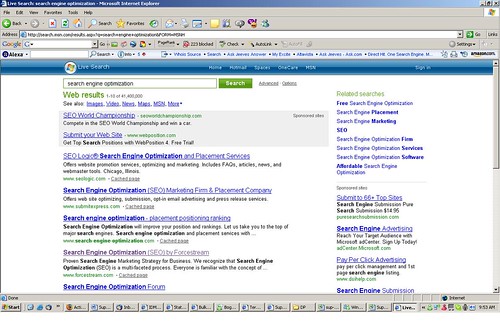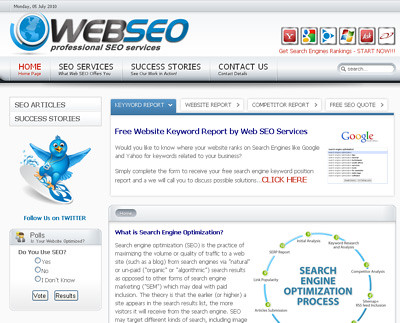A few years ago, the Internet experienced a video revolution. As broadband access expanded and more people began uploading content, video became an expected resource for consumers. Businesses could get more mileage out of television commercials and engage users by linking to video reviews of its products.
A year ago, we saw evidence of small and medium-sized business increasing budgets for video content – to be used both on their homepages and in advertisements. In 2009, 19% of businesses polled were using video (up from 5% in 2008) and I’m willing to bet that number will be much higher in the 2010 report that should come out later this month.
Now, as technology has become more affordable and increasingly mobile, we’re able to experience virtually anything online. As such, local search engines are evolving into master content synthesizers to meet the needs of consumers and advertisers alike – offering video and photos, local advertising deals, user reviews, QR codes, maps and directions, etc.
Consumer expectations of local search engines have never been higher. Users want to see photo and video reviews of a company’s products, read what other people have to say, and even take a virtual tour of your store or restaurant before they visit.
The same is true of small- and medium-sized business owners looking to find a competitive advantage. Local search engines are offering more dynamic content than ever before to users and it’s up to search marketers to help business owners feed that content.
It’s interesting to see how video content has changed since the advent of YouTube. Instead of traditional video advertising, we’re seeing new technology that lets users look around your business from their own home. Soon, we’ll be able to find virtual creations of almost any environment online – and those virtual tours are being integrated with current deals and other advertising promotions to drive traffic to your business.
Recently, a company called EveryScape partnered with Bing and YP to offer digital advertisers a new local search solution – virtual tours. For example, YP360 will let a user step inside a restaurant in Baltimore while they’re still on the train. They can choose a place and even set a reservation, all within the same application on their phone.
Google Earth has gone indoors and local search engines are responsible for bringing this detailed and vivid content to users while keeping it simple and accessible. And the business case for offering this new content to users and advertisers alike is clear as local advertising is expected to grow to $16.1 billion this year, up from $13.7 billion in 2010.
Even more, mobile phone advertising spending is expected to be more than a billion dollars in 2011, up 48% from 2010. Local search engines like YP and Yelp! are seeing over 20 million visitors a month, many of them accessing via mobile phones.
This is a great opportunity for local search engines and advertisers to embrace this new technology and get ahead of the pack. Effective local advertising goes beyond building a social networking presence and listing in directories – you have to make sure your content is engaging. In the online world, the savviest local search marketers who use this technology well will have the most successful campaigns.
I recommend that any business owner or local search marketer read up on the latest digital advertising solutions and consider offering your customers virtual tours of your products or store. To set your business apart, you need to stay current with the best that local search has to offer.
Opinions expressed in the article are those of the guest author and not necessarily Search Engine Land.
Related Topics: Locals Only
A few years ago, the Internet experienced a video revolution. As broadband access expanded and more people began uploading content, video became an expected resource for consumers. Businesses could get more mileage out of television commercials and engage users by linking to video reviews of its products.
A year ago, we saw evidence of small and medium-sized business increasing budgets for video content – to be used both on their homepages and in advertisements. In 2009, 19% of businesses polled were using video (up from 5% in 2008) and I’m willing to bet that number will be much higher in the 2010 report that should come out later this month.
Now, as technology has become more affordable and increasingly mobile, we’re able to experience virtually anything online. As such, local search engines are evolving into master content synthesizers to meet the needs of consumers and advertisers alike – offering video and photos, local advertising deals, user reviews, QR codes, maps and directions, etc.
Consumer expectations of local search engines have never been higher. Users want to see photo and video reviews of a company’s products, read what other people have to say, and even take a virtual tour of your store or restaurant before they visit.
The same is true of small- and medium-sized business owners looking to find a competitive advantage. Local search engines are offering more dynamic content than ever before to users and it’s up to search marketers to help business owners feed that content.
It’s interesting to see how video content has changed since the advent of YouTube. Instead of traditional video advertising, we’re seeing new technology that lets users look around your business from their own home. Soon, we’ll be able to find virtual creations of almost any environment online – and those virtual tours are being integrated with current deals and other advertising promotions to drive traffic to your business.
Recently, a company called EveryScape partnered with Bing and YP to offer digital advertisers a new local search solution – virtual tours. For example, YP360 will let a user step inside a restaurant in Baltimore while they’re still on the train. They can choose a place and even set a reservation, all within the same application on their phone.
Google Earth has gone indoors and local search engines are responsible for bringing this detailed and vivid content to users while keeping it simple and accessible. And the business case for offering this new content to users and advertisers alike is clear as local advertising is expected to grow to $16.1 billion this year, up from $13.7 billion in 2010.
Even more, mobile phone advertising spending is expected to be more than a billion dollars in 2011, up 48% from 2010. Local search engines like YP and Yelp! are seeing over 20 million visitors a month, many of them accessing via mobile phones.
This is a great opportunity for local search engines and advertisers to embrace this new technology and get ahead of the pack. Effective local advertising goes beyond building a social networking presence and listing in directories – you have to make sure your content is engaging. In the online world, the savviest local search marketers who use this technology well will have the most successful campaigns.
I recommend that any business owner or local search marketer read up on the latest digital advertising solutions and consider offering your customers virtual tours of your products or store. To set your business apart, you need to stay current with the best that local search has to offer.
Opinions expressed in the article are those of the guest author and not necessarily Search Engine Land.
Related Topics: Locals Only
Surface Encounters
Barry Bonds trial: Former Giants trainer takes the stand
![]() Major leaguers Jason and Jeremy Giambi were expected to testify Tuesday as Barry Bonds' perjury trial resumed.
Major leaguers Jason and Jeremy Giambi were expected to testify Tuesday as Barry Bonds' perjury trial resumed.
Surface Encounters
Jon Stewart Calls Out NBC <b>News</b> For Not Reporting on GE's $0 Tax <b>...</b>
On Friday, The New York Times reported that General Electric paid no U.S. federal income tax in 2010, despite earning $14.2 billion in profits. While.
Surface Encounters
Heavy Fire Afghanistan coming to Kinect Xbox 360 <b>News</b> - Page 1 <b>...</b>
Read our Xbox 360 news of Heavy Fire Afghanistan coming to Kinect.
Surface Encounters
With few surprises, techies were underwhelmed with Apple’s iPad 2 announcement, but I’m confident that consumers will be thrilled with the product. Apple already had a massive lead in the consumer tablet market it created, and these “underwhelming” upgrades should keep the company comfortably ahead. Apple has given competitors an opening by sticking to 3G, and it did not further pressure them with a lower entry price point or higher-resolution display. However, Apple has three critical advantages.
1. Brand: When consumers are thinking about tablets, they say they are buying an “iPad,” not a “tablet.” The iPad was already the category and volume leader, and the iPad 2 builds on that. In this respect, Apple actually benefits from the crowd of new tablets hitting the market. If there were only one or two strong competitors, consumers would be able to weigh the pros and cons of each offering, but with dozens and dozens of options hitting the market over the next few months, decision paralysis can set in and many consumers will throw up their hands and make the “safe” choice: the iPad.
2. iTunes: The iPad is still the only tablet on the market with a huge digital marketplace for movies, TV shows, and music. Some competitors are taking steps in this direction (e.g., Samsung’s Hub), but iTunes remains a significant competitive advantage.
3. App Store: If all you want to do is browse the Web and check e-mail, any tablet will probably suffice. However, Apple has an enormous lead in purpose-built apps. The Android ecosystem is strong and app availability should improve significantly over time, but the iPad 2 is considerably more versatile than any of its competitors right now, and it appears unlikely to lose its lead any time in the near future.
So if you are competing with Apple, what should you do? Rather than copying Apple’s products, copy its old advertising tag line and Think Different.
Apple’s brand is focused on creative types (or those who aspire to be), which is why it spends so much effort creating things like GarageBand. Competitors should target IT managers, knowledge workers, outdoorsy people, or some other group and build software and hardware combinations better suited to those use cases. Of course, this will take imagination and the ability to tie hardware, software, and services together to build unique experiences. There are some companies thinking outside the box (HTC and RIM have clearly differentiated products on their roadmaps), but for the vendors who are trying to out-Apple Apple… good luck. Here are some pointers, you’re going to need them:
• Based on Apple’s financials, it is clear that the iPad with WiFi is Apple’s volume product and 3G versions are merely gravy. Why is the competition only targeting the gravy?
• iTunes remains a significant competitive advantage for Apple – I cannot easily explain to novices how to get a movie onto the XOOM. Rivals need an “iTunes” of their own, but having one just achieves parity with Apple, so partnering is an acceptable approach. However, half measures are not enough; digital media stores must include movies (including rentals) and TV shows and music. If multiple partners are used, the tablet vendor still needs to provide a common interface and single account/billing relationship.
• Nintendo has a significant base of game developers targeting the 3DS; if you cannot muster equivalent resources (for gaming, media playback, or some other use), adding 3D to your tablet is just a gimmick.
• Apple’s rivals can compete on 4G, higher-resolution displays, or a lower price. Even speed is a potential differentiator from a technical perspective; NVIDIA has quad-core processors sampling this month, so rivals could build even faster tablets for this holiday season. However, I must still caution vendors that all of these factors are irrelevant if consumers do not want your product.
For Apple, the mobile market is a cash cow. The company’s iPhone and iPad are proving to be the top mobile companions for people around the globe. Apple has sold over 100 million iPhones. Its iPad sales have hit 15 million. The company understands the mobile market and it knows how to capitalize on it.
But what about the living room? It has the Apple TV, sure, and the Mac mini is often times connected to an HDTV, but what else has Apple done to push the envelope in the living room? It still hasn’t launched the long-rumored television we keep hearing about, and it seems that offering a game console — a hope for many Apple fans over the past few years — won’t happen.
I fully realize that Apple can’t be everything to every customer. It delivers computers, smartphones, tablets, personal media players, two operating systems, wireless routers, and much more. But I also realize that Apple is an entertainment company. It’s about trying to give people more opportunity to enjoy their lives through technology. And it would only make sense if it doubled down on the living room.
Let’s turn our attention to the Apple TV for a minute.
Prior to its announcement in September, rumors were running rampant over what the former “hobby” would offer. Folks thought it would deliver gaming, interface with DVRs, include Apple’s App Store, and much more. They thought it would be a sizable update over its predecessor.
Instead, Apple offered a stripped-down alternative.
The second-generation Apple TV comes with the ability for users to stream Netflix content. It has Flickr and Internet radio. And it allows users to stream their music over their home network to their televisions. It offers movies and television shows, as well, but most would agree that it’s slim pickings for now.
At that event in September, Steve Jobs said that Apple’s research showed customers didn’t want everything a company could pile into a device. They simply want the ability to consume the content they enjoy without the fuss that might come along with something like Google TV-based devices.
But by delivering the bare minimum, Apple did itself no favors. The company took the easy way out and pretended like it no longer views the living room as a hobby. The only issue is, the Apple TV is still a hobby. It’s a device that lacks all the functionality we’ve come to expect from Apple — a company that typically prides itself on offering the best value for the cash. And at least so far, it leaves me wanting more.
So, what am I looking for? I want to see Apple improve the Apple TV by bringing its App Store to the platform. I’d also like to see some kind of gaming component come to the device, either through the App Store or as part of a more-capable platform.
And perhaps most importantly, I’d like to see Apple think beyond its set-top box and deliver products that try something new. I’m not sold on the possibility of Apple offering a groundbreaking television, but if it can surprise me, I’m all for it.
Simply put, I’m looking for Apple to be Apple. Right now, it’s just like every other company in the living room; it’s content to have a presence but not dominate.
That needs to end.
No single company can stake claim to the living room right now. Steve Jobs just needs to take advantage of that void and do something special.
But first, he needs to take the living room — and its revenue potential — seriously.
Surface Encounters
Surface Encounters
The major legislative item on the agenda in the Senate this week will be The Small Business Reauthorization Act (S. 493). Republicans plan to use this bill as a platform to promote critical pieces of legislation through the process of non-germane amendments to the bill. Here are some vital amendments that will be debated and voted on throughout the week:
- Senator Mitch McConnell is offering an amendment (S. AMDT 183) to prohibit the EPA from promulgating any regulations on greenhouse gas emissions. There is perhaps no force that is more destructive to our prosperity, consumer freedom of choice, and job creation than onerous cap and trade schemes. There are many red state Democrats who are up for reelection in 2012 and will be hard pressed to go on record as supporting policies that are an imprecation to the interests of their states. Make sure to call Senators Claire McCaskill, Joe Manchin, Ben Nelson, Bill Nelson, and Jon Tester in particular.
- Senator David Vitter is offering an amendment (S.AMDT. 178) forcing the federal government to sell off unused and underused property. This is a serious issue. The federal government owns over half of the land in some western states and has been using it to stifle energy development. Selling unused federal lands would also serve as a prudent means of generating revenue without raising taxes.
- Senator Rand Paul is using the SBA bill as a platform to offer his signature budget bill (S.AMDT 199) which would slash $200 billion in spending for fiscal 2011. Paul’s plan slashes funding by 50% to the Departments of Energy, Education, and HUD. This amendment represents real limited government and budget austerity and will separate the men among the boys in the ranks of the Republican Conference.
- Senator Kay Bailey Hutchison is forcing a vote (S. AMDT 197) to delay the implementation of ObamaCare until a final resolution is reached in pending lawsuits. Unlike other bills that are designed to merely ameliorate ObamaCare, this amendment would completely halt it during the ensuing legal battles.
- Senator Tom Coburn has filed an amendment (S.AMDT.184) to force federal agencies to compile comprehensive lists of all of their programs
Make sure that all of your Republican senators are on record supporting these amendments, especially Rand Paul’s budget proposal. Also, let’s see which faux moderate Democrats will commit to supporting anyone of these commonsense initiatives. Needless to say, I didn’t waste time calling my senators; Barbara Mikulski and Ben Cardin!
What is your social media brand? Do you have one? Sure, many small business owners and entrepreneurs are coming around to the enormous importance of social media as a marketing, customer service, and, yes, even sales tool. But if you haven’t thought about how social media can define your brand, you are probably missing a HUGE part of what social media tools can do for your business. Here’s more…
Tools & Techniques
Creating a great brand with these blog tools. Tools that improve the look and functionality of your blog also improve your brand. A well-maintained small business blog is one of the most obvious and least expensive branding tools at the entrepreneur’s disposal even more so than social media channels like Facebook and Twitter because of how a blog can be customized to fit your needs and personality. This list of tools is a great way to start. EpicLaunch
What Nicole “Snooki” Polizzi can teach you about social media. One of the stars of the hit reality show “Jersey Shore”, “Snooki” is a perfect example of personal brand, but social media entrepreneurs could also learn much about building their own online presence from Snooki. Being yourself and using a simple, short tag to indelibly brand your identity are also great techniques in social media. One site is already trying to apply the starlets techniques in the social media space. Brand-Yourself
Tito Philips doesn’t want your comments on his blog! At least, not if they’re the wrong kind. And the wrong kind would be comments left for no other purpose than to get the blogger and his/her readers to visit your blog and perhaps comment on it in return. Why is comment trading bad? Don’t get Tito started! There are many ways to engage in social media marketing. Be sure you understand and respect some of the attitudes you may face. Blogging Bookshelf
News & Trends
The best of the best. Want to get a look at arguably the 20 best Facebook fan pages for business on the planet? By now you should know the value of a Facebook fan page to your branding efforts. What’s also true, however, is that not all Facebook sites are created equal. If you want to take your social media marketing to the next level, have a look at this list of cream of the crop sites. Inc.com
Even churches use social media marketing! In this article on the growing market for tech services among religious organizations, we learn that many churches have also already entered into the social media space. As houses of worship, particularly huge mega-churches, expand and build congregations, it’s easy to see how social media can work as a marketing tool here as well. Is your religious organization using social media for branding? WSJ
Tips & Tricks
20 tips that will make you a Twitter star. Among the tools popular in the new digital space is Twitter. The microblogging platform can be used for business or non-business purposes and it can be the key to your small business’s success. Learn how to use Twitter like a pro and you may be surprised at the benefits your small business gains as a result. Global Copywriting
Valuable lessons in social media. Gary Vaynerchuk, author of The Thank You Economy and a successful social media entrepreneur in his own right, has many insights to share with small business leaders seeking a new way to define their brands in an age of social communications. Read some of the takeaways Vaynerchuk shares with those trying to define their businesses with social media. E-Marketing Associates
Success Stories
Doubt the power of FB to create brand for almost anyone? You won’t after you read the story of Princeton English Professor Jeff Nunokawa and “Jeffbook”, a collection of 3,221 brief literary essays on Facebook, that have created an incredible cult status for Nunokawa in the process. His motivation? Not too different from those of most marketers. Nunokawa simply started sharing where he knew his audience already spent lots of their time. The results speak for themselves. Fast Company
Increase exposure with niche social media. Blogger Mavis Nong talks about the importance of niche social media sites including social bookmarking sites as a key method of creating exposure for your online business. Mavis talks about her experience with our sister site BizSugar.com (thanks for the shout out! ) and explains how smaller more focused social sites can sometimes have a surprising impact even larger than the big guys. Attraction Marketing Online
Opportunities
Sponsors wanted for new SugarTone Sweet Business Blogging Contest. Put the power of social media to work for your brand. We’re looking for sponsors to help with a brand new blogging contest involving two of the fastest growing small business communities on the Web, BizSugar.com and Bloggertone.com. Learn more about the contest by reading the full announcement and get in touch today! BizSugar Blog
Surface Encounters
Japan Nuke Accident Seen From Seattle - Science <b>News</b>
Clues to events at crippled plant found in traces of radiation reaching Pacific Northwest.
Surface Encounters
Surface Encounters
Surface Encounters
REPORT: <b>News</b> Corp. In Talks To Hand Over Control Of MySpace To <b>...</b>
News Corp. is in preliminary talks to give control of Myspace to Vevo.com, the site partly owned by top record companies, including Universal Music and Sony Music, according to a Bloomberg report. News Corp. has been looking to unload ...
Surface Encounters

















